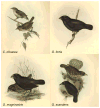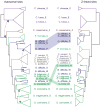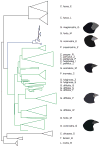Divergence and gene flow among Darwin's finches: A genome-wide view of adaptive radiation driven by interspecies allele sharing
- PMID: 26200327
- PMCID: PMC4659394
- DOI: 10.1002/bies.201500047
Divergence and gene flow among Darwin's finches: A genome-wide view of adaptive radiation driven by interspecies allele sharing
Abstract
A recent analysis of the genomes of Darwin's finches revealed extensive interspecies allele sharing throughout the history of the radiation and identified a key locus responsible for morphological evolution in this group. The radiation of Darwin's finches on the Galápagos archipelago has long been regarded as an iconic study system for field ecology and evolutionary biology. Coupled with an extensive history of field work, these latest findings affirm the increasing acceptance of introgressive hybridization, or gene flow between species, as a significant contributor to adaptive evolution. Here, we review and discuss these findings in relation to both classical work on Darwin's finches and contemporary work showing similar evolutionary signatures in other biological systems. The continued unification of genomic data with field biology promises to further elucidate the molecular basis of adaptation in Darwin's finches and well beyond.
Keywords: adaptation; adaptive radiation; genomics; hybridization; introgression.
© 2015 WILEY Periodicals, Inc.
Figures




Similar articles
-
Adaptive radiation of Darwin's finches revisited using whole genome sequencing.Bioessays. 2016 Jan;38(1):14-20. doi: 10.1002/bies.201500079. Epub 2015 Nov 25. Bioessays. 2016. PMID: 26606649 Review.
-
Darwin's Galapagos finches in modern biology.Philos Trans R Soc Lond B Biol Sci. 2010 Apr 12;365(1543):1001-7. doi: 10.1098/rstb.2009.0321. Philos Trans R Soc Lond B Biol Sci. 2010. PMID: 20194163 Free PMC article.
-
Evolution of Darwin's finches and their beaks revealed by genome sequencing.Nature. 2015 Feb 19;518(7539):371-5. doi: 10.1038/nature14181. Epub 2015 Feb 11. Nature. 2015. PMID: 25686609
-
Sisyphean evolution in Darwin's finches.Biol Rev Camb Philos Soc. 2015 Aug;90(3):689-98. doi: 10.1111/brv.12127. Epub 2014 Jul 9. Biol Rev Camb Philos Soc. 2015. PMID: 25040800
-
Every inch a finch: a commentary on Grant (1993) 'Hybridization of Darwin's finches on Isla Daphne Major, Galapagos'.Philos Trans R Soc Lond B Biol Sci. 2015 Apr 19;370(1666):20140287. doi: 10.1098/rstb.2014.0287. Philos Trans R Soc Lond B Biol Sci. 2015. PMID: 25750230 Free PMC article. Review.
Cited by
-
Patterns of gene flow and selection across multiple species of Acrocephalus warblers: footprints of parallel selection on the Z chromosome.BMC Evol Biol. 2016 Jun 16;16(1):130. doi: 10.1186/s12862-016-0692-2. BMC Evol Biol. 2016. PMID: 27311647 Free PMC article.
-
Endless forms most frustrating: disentangling species boundaries in the Ramalina decipiens group (Lecanoromycetes, Ascomycota), with the description of six new species and a key to the group.Persoonia. 2024 Aug;52:44-93. doi: 10.3767/persoonia.2024.52.03. Epub 2024 May 10. Persoonia. 2024. PMID: 39161630 Free PMC article.
-
"Bringing Taxonomy to the Service of Genetics": Edgar Anderson and Introgressive Hybridization.J Hist Biol. 2016 Dec;49(4):603-624. doi: 10.1007/s10739-016-9436-9. J Hist Biol. 2016. PMID: 26869463
-
Female-biased dispersal and non-random gene flow of MC1R variants do not result in a migration load in barn owls.Heredity (Edinb). 2019 Mar;122(3):305-314. doi: 10.1038/s41437-018-0115-9. Epub 2018 Jul 13. Heredity (Edinb). 2019. PMID: 30006569 Free PMC article.
-
Living Organisms Author Their Read-Write Genomes in Evolution.Biology (Basel). 2017 Dec 6;6(4):42. doi: 10.3390/biology6040042. Biology (Basel). 2017. PMID: 29211049 Free PMC article. Review.
References
-
- Darwin CR, Wallace AR. On the tendency of species to form varieties; and on the perpetuation of varieties and species by natural means of selection. Zool J Linn Soc. 1858;3:46–50.
-
- Hoekstra HE, Coyne JA. The locus of evolution: evo devo and the genetics of adaptation. Evolution. 2007;61:995–1016. - PubMed
-
- Martin A, Orgogozo V. The loci of repeated evolution: a catalog of genetic hotspots of phenotypic variation. Evolution. 2013;67:1235–50. - PubMed
Publication types
MeSH terms
Grants and funding
LinkOut - more resources
Full Text Sources
Other Literature Sources

